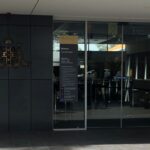Sydney Kebab Shop Shooting May Be Linked to Organised Crime

Police say a 26-year old man and 47-year old woman are in a stable condition, and a 25-year old man is in a serious condition, after two masked assailants entered a kebab shop on South Parade in Auburn at about 1.15pm on Monday, 16 June 2025 and fired eight rounds.
The 26-year old suffered wounds to his shoulder and arm, the 47-year old was shot twice in her torso and the 25-year old was shot in the face, before the assailants left the scene in a black Audi Q7 with cloned numberplates.
Fourth attempt
New South Wales Detective Superintendent Jason Box told the media that the incident is the fourth attempt on the life of 26-year old victim Samimjan Azari, who is ‘known to police’.
Investigations are now underway as to whether the shooting is part of a spate of shootings across Sydney relating to organised criminal activity.
Task Force Falcon
Task Force Falcon is one of several arms of law enforcement responsible for investigating shootings believed to be associated with organised crime in Sydney, and bringing suspected offenders before the courts.
The task force comprises 150 staff including 100 detectives, and is currently investigating dozens of incidents believed to be associated with “conflict within criminal networks… related to drug supply matters”.
Deputy Police Commissioner David Hudson told the media that of 25 murders since 2021 believed to be related to organised crime, 20 have been solved and investigations are continuing into the remainder, as well as into many other incidents that did not result in fatalities, including other shootings, arson attacks and attempted kidnapping.
Increase in violent offences
New South Wales saw the highest number of murders within the last decade in 2024, according to the NSW Bureau of Crime Statistics and Research.
Statistics suggest that the state identified 85 murders in the previous year, a dramatic increase from 58 victims in 2023 — and the most the state has had since 2014.
According to BOCSAR, there was a 46.5% increase in the homicide rate between 2023 and 2024, with 46 men, 26 women, and 13 young people/children being the victims of murders in 2024. The highest murder rates were recorded in Sydney’s eastern suburbs, Bondi, Richmond-Tweed, Coffs Harbour-Grafton, and Parramatta.
The state has also seen an increase in overall violent offence rates since 2019, and a spike in nearly all violence offence categories over the past two years, with the highest increases being in the Greater Sydney area.
The offence of discharging a firearm with intent in NSW
Discharging a Firearm with Intent is an offence under section 33A of the Crimes Act 1900 which carries a maximum penalty of 25 years in prison.
To establish the offence, the prosecution must prove beyond reasonable doubt that a person:
- Discharged a firearm or other loaded arms or attempted to do so, and
- Intended by doing so to cause grievous bodily harm to another person or to resist or prevent a lawful arrest or detention
A ‘firearm’ is defined as gun, or other weapon, that is or was, capable of propelling a projectile by means of an explosive. It includes a blank fire firearm, or an air gun, but does not include a paintball marker.
‘Grievous bodily harm’ has been defined as ‘really serious harm’ it includes, but is not limited to:
- Any permanent or serious disfigurement
- The destruction of a foetus, other than by a medical procedure, and
- Any grievous bodily disease
The offence of wounding or causing grievous bodily harm with intent in NSW
Wounding or causing grievous bodily Harm with intent is an offence under section 33 of the Crimes Act 1900 which carries a maximum penalty of 25 years in prison.
To establish the offence, the prosecution must prove beyond reasonable doubt that a person:
- Caused grievous bodily harm to another person, or wounded another person, and
- Intended to do so.
A ‘wound’ is the breaking of both layers of the skin being the dermis and epidermis and includes a ‘split lip’.
The offence carries a ‘standard non-parole period’ of 7 years which is a reference point for the sentencing judge when deciding how long a person must spend in prison before being eligible to apply for release on parole.
Defences to the charges
In the event there is evidence of a legal defence to either of the above charges, the prosecution must prove beyond reasonable doubt that the defence does not apply to the circumstances of the case.
A person must be found not guilty if the prosecution is unable to do this.
Legal defences to the charges include self-defence, duress, necessity, automatism and mental illness.
Going to court?
If you or a loved-one has been charged with a criminal offence, call Sydney Criminal Lawyers on (02) 9261 8881 to arrange a conference with a specialist criminal defence lawyer with years of experience in defending and winning criminal cases.







